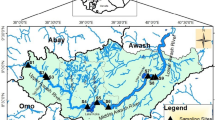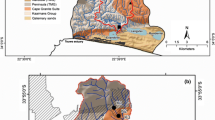Abstract
Multimetric indices based on fish and benthic macroinvertebrate assemblages are commonly used to assess the biological integrity of aquatic ecosystems. However, their response to specific stressors is rarely known. We quantified the response of a fish-based index (Mid-Atlantic Highlands Index of Biotic Integrity, MAH-IBI) and a benthic invertebrate-based index (West Virginia Stream Condition Index, WV-SCI) to acid mine drainage (AMD)-related stressors in 46 stream sites within the Cheat River watershed, West Virginia. We also identified specific stressor concentrations at which biological impairment was always or never observed. Water chemistry was extremely variable among tributaries of the Cheat River, and the WV-SCI was highly responsive across a range of AMD stressor levels. Furthermore, impairment to macroinvertebrate communities was observed at relatively low stressor concentrations, especially when compared to state water quality standards. In contrast to the WV-SCI, we found that the MAH-IBI was significantly less responsive to local water quality conditions. Low fish diversity was observed in several streams that possessed relatively good water quality. This pattern was especially pronounced in highly degraded subwatersheds, suggesting that regional conditions may have a strong influence on fish assemblages in this system. Our results indicate that biomonitoring programs in mined watersheds should include both benthic invertebrates, which are consistent indicators of local conditions, and fishes, which may be indicators of regional conditions. In addition, remediation programs must address the full suite of chemical constituents in AMD and focus on improving linkages among streams within drainage networks to ensure recovery of invertebrate and fish assemblages. Future research should identify the precise chemical conditions necessary to maintain biological integrity in mined Appalachian watersheds.




Similar content being viewed by others
References
Barbour MT, Gerritsen J, Snyder BD, Stribling JB (1999) Rapid bioassessment protocols for use in streams and wadeable rivers: periphyton, benthic macroinvertebrates and fish, second edition. EPA 841-B-99-002. U.S. EPA; Office of Water; Washington, D.C
Cardwell DH, Erwin RH, Woodward HP, Lotz CW (1968) Geologic map of West Virginia. West Virginia Geologic and Economic Survey
Clements WH (2004) Small-scale experiments support causal relationships between metal contamination and macroinvertebrate community response. Ecological Applications 14:954–967
Clesceri LS, Greenberg AE, Eaton AD (eds) (1992) Standard Methods for the Examination of Water and Wastewater, 18th Edition. American Public Health Association, Washington, D.C
Detenbeck NE, DeVore PW, Niemi GJ, Lima A (1992) Recovery of temperate-stream fish communities from disturbance: a review of case studies and synthesis of theory. Environmental Management 16:33–53
Fausch KD, Torgersen CE, Baxter CV, Li HW (2002) Landscapes to riverscapes: Bridging the gap between research and conservation of stream fishes. BioScience 52:483–498
Freund JG (2004) Local and regional impairment of fish assemblages in a mined Appalachian watershed. Ph. D. dissertation, West Virginia University, Morgantown
Hansen JA, Woodward DF, Little EE, DeLonay AJ, Bergman HJ (1999) Behavioral avoidance: possible mechanism for explaining abundance and distribution of trout species in a metal-impacted stream. Environmental Toxicology and Chemistry 18:313–317
Hilsenhoff WL (1982) Using a biotic index to evaluate water quality in streams. Wisconsin Department of Natural Resources Technical Bulletin 132:22
Hilsenhoff WL (1988) Rapid field assessment of organic stream pollution. Journal of North American Benthological Society 7(1):65–68
Jones EBI, Helfman GS, Harper JO, Bolstad PV (1999) Effects of riparian forest removal on fish assemblages in southern Appalachian streams. Conservation Biology 13: 1454–1465
Karr JR (1981) Assessment of biotic integrity using fish communities. Fisheries 6:91–107
Kerans BL, Karr JR (1994) A benthic index of biotic integrity (B-IBI) for rivers of the Tennessee Valley. Ecological Applications 4(4):768–785
Kilgour BW, Barton DR (1999) Associations between stream fish and benthos across environmental gradients in southern Ontario, Canada. Freshwater Biology 41:553–566
Lammert M, Allan JD (1999) Assessing biotic integrity of streams: Effect of scale in measuring the influence of land use/cover and habitat structure on fish and macroinvertebrates. Environmental Management 23:257–270
Leonard PM, Orth DJ (1986) Application and testing of an index of biotic integrity in small, coolwater streams. Transactions of the American Fisheries Society 115:401–404
Lonzarich Jr. DG, Warren ML, Lonzarich MRE (1998) Effects of habitat isolation on the recovery of fish assemblages in experimentally defaunated stream pools in Arkansas. Canadian Journal of Fisheries and Aquatic Sciences 55:2141–2149
Lyons J (1992) The length of stream to sample with a towed electrofishing unit when fish species richness is estimated. North American Journal of Fisheries Management 12:198–203
Lyons J, Wang L, Simonson TD (1996) Development and validation of an index of biotic integrity for coldwater streams in Wisconsin. North American Journal of Fisheries Management 16:241–256
Maret TR, MacCoy DE (2002) Fish assemblages and environmental variables associated with hard-rock mining in the Coeur d’Alene River basin, Idaho. Transactions of the American Fisheries Society 131:865–884
Maret TR, Oh DS (2004) Assessment of fish assemblages and minimum sampling effort required to determine biotic integrity of large rivers in Southern Idaho, 2002. Water-Resources Investigations Report 03-4274. United States Geological Survey, Reston, VA, 16 pp
Matthews WJ, Robison HW (1998) Influence of drainage connectivity, drainage area, and regional species richness on fishes of the interior highlands in Arkansas. The American Midland Naturalist 139:1–19
McCormick FH, Hughes RM, Kaufmann PR, Peck DV, Stoddard JL, Herlihy AT (2001) Development of an index of biotic integrity for the mid-Atlantic Highland Region. Transactions of the American Fisheries Society 130:857–877
McGarigal K, Cushman S, Stafford S (2000) Multivariate statistics for wildlife and ecology research. Springer-Verlag, New York, 283 pp
Mebane CA (2001) Testing bioassessment metrics: macroinvertebrate, sculpin, and salmonid responses to stream habitat, sediment, and metals. Environmental Monitoring and Assessment 67:293–322
Merovich G, Petty JT (2007) Interactive effects of multiple stressors and restoration priorities in a mined Appalachian watershed. Hydrobiologia 575:13–31
Ohio Environmental Protection Agency (1989) Biological criteria for the protection of aquatic life. Vol. III. Users manual for biological field assessment of Ohio surface waters. Division of Water Quality Monitoring and Assessment, Surface Water Section, Columbus, OH
Osborne LL, Wiley MJ (1992) Influence of tributary spatial position on the structure of warmwater fish communities. Canadian Journal of Fisheries and Aquatics Sciences 49:671–681
Osborne LL, Kohler SL, Bayley PB, Day DM, Bertrand WA, Wiley MJ, Sauer R (1992) Influence of stream location in a drainage network on the index of biotic integrity. Transactions of the American Fisheries Society 121:635–643
Paller MH (2001) Comparison of fish and macroinvertebrate bioassessments from South Carolina coastal plain streams. Aquatic Ecosystem Health and Management 4(2):175–186
Paul MJ, Meyer JL (2001) Streams in the urban landscape. Annual Review of Ecology and Systematics 32:333–365
Petty JT, Barker J (2004) Water quality variability, trace metals and implications for restoring a mined Appalachian watershed. Proceedings of the National Meeting of the American Society of Mining and Reclamation. ASMR, Lexington, KY. (Available as of June 2004 at http://www.ces.ca/uky.edu/asmr/Publications.htm)
Petty JT, Lamothe PA, Mazik P (2005) Spatial and seasonal dynamics of brook trout populations in a central Appalachian watershed. Transactions of the American Fisheries Society 134:572–587
Pinder MJ, Morgan RP II (1995) Interactions of pH and habitat on cyprinid distributions in Appalachian streams of Maryland. Transactions of the American Fisheries Society 124:94–102
Pirhalla DE (2004) Evaluating fish-habitat relationships for refining regional indexes of biotic integrity: development of a tolerance index of habitat degradation for Maryland stream fishes. Transactions of the American Fisheries Society 133:144–159
Roper BB, Scharnecchia DL (1995) Observer variability in classifying habitat types in stream surveys. North American Journal of Fisheries Management 15:49–53
Schlosser IJ (1995) Critical landscape attributes that influence fish population dynamics in headwater streams. Hydrobiologia 303:71–81
Schlosser IJ, Angermeier PL (1995) Spatial variation in demographic processes of lotic fishes: conceptual models, empirical evidence, and implications for research. American Fisheries Society Symposium 17:392–401
Shields Jr. FD, Knight SS, Cooper CM (1995) Use of the index of biotic integrity to assess physical habitat degradation in warmwater streams. Hydrobiologia 312:191–208
Sloane PIW, Norris RH (2003) Relationship of AUSRIVAS-based macroinvertebrate predictive model outputs to a metal pollution gradient. Journal of the North American Benthological Society 22:457–471
Snyder CD, Young JA, Villella R, Lemarié DP (2003) Influences of upland and riparian land use patterns on stream biotic integrity. Landscape Ecology 18:647–664
Suter GW, Norton II, Norton SB, Cormier SM (2002) A method for inferring the causes of observed impairments in aquatic ecosystems. Environmental Toxicology and Chemistry 21:1101–1111
Sutherland AB, Meyer JL, Gardiner EP (2002) Effects of land cover on sediment regime and fish assemblage structure in four southern Appalachian streams. Freshwater Biology 47:1791–1805
Tetra Tech, Inc. (2000) A stream condition index for West Virginia wadeable streams. Owings Mills, MD. (Available as of June 2005 http://www.dep.state.wv.us/Docs/536_WV-Index.pdf)
Townsend CR, Dolédec S, Norris R, Peacock K, Arbuckle C, (2003) The influence of scale and geography on relationships between stream community composition and landscape variables: description and prediction. Freshwater Biology 48:768–785
Wallace JB, Grubaugh JW, Whiles MR (1996) Biotic indices and stream ecosystem processes: results from an experimental study. Ecological Applications 6:140–151
Whittier TR, Paulsen SG, Larsen DP, Peterson SA, Herlihy AT, Kaufmann PR (2002) Indicators of ecological stress and their extent in the populations of Northeastern lakes: a regional-scale assessment. BioScience 52:235–247
Welsh SA, Perry SA (1997) Acidification and fish occurrence in the upper Cheat River drainage, West Virginia. Journal of the American Water Resources Association 33:423–429
West Virginia Environmental Quality Board (WV-EQB) (2004) Title 46: series 1, requirements governing water quality standards. WV-EQB, Charleston, WV. 70 pp. [Available on-line: http://www.wvsos.com/adlaw/proposed/46-01er.pdf]
Williams DR, Clark ME, Brown JB (1999) Stream water quality in coal mined areas of the lower Cheat River basin, West Virginia and Pennsylvania, during low-flow conditions, July 1997. Water Resource Investigations Report 98–4258, 8 pp
Woodward DF, Goldstein JN, Farag AM, Brumgaugh WG (1997) Cutthroat trout avoidance of metals and conditions characteristic of a mining waste site: Coeur d’ Alene River, Idaho. Transaction of the American Fisheries Society 126:699–706
WVDEP (1996) An ecological assessment of the Cheat River watershed. West Virginia Division of Environmental Protection. Report 0502004–1996, Charleston, WV
WVDEP (2003) Benthic invertebrate sampling, processing, and analysis: standard operating procedures. West Virginia Division of Environmental Protection, Charleston, WV
Yoder CO, Smith MA (1999) Using fish assemblages in a state biological assessment and criteria program: essential concepts and considerations. In: Smith TP (ed) Assessing the sustainability and biological integrity of water resources using fish communities. CRC Press, Boca Raton, Florida. Pages 17–56
Zar JH (1999) Biostatistical analysis: fourth edition. Prentice Hall, Upper Saddle River, New Jersey
Acknowledgments
This research was completed in partial fulfillment of the corresponding author’s dissertation. Funding was provided through grants from the Electrical Power Research Institute, the WV Water Research Institute, and a USEPA STAR grant to J.T.P. The authors wish to thank Alan Herlihy (US EPA) for providing technical assistance and reference equations to calculate MAH-IBI scores from our data. John Wirts of the WVDEP provided WV-SCI scores and information pertaining to the development of the index. Jennifer Fulton oversaw the collection of water chemistry data, organized data and labor, and assisted with fish collections. Roy Martin assisted with site selection and supervised a second field crew. The following undergraduate technicians and graduate students assisted with fish collections: Patrick Amick, Patrick Blosser, Luke Bolyard, Ryan Braham, Seth Davis, Brandon Keplinger, Pete Lamothe, Zach Liller, Sarah McClurg, George Merovich, Aurora Moldovanyi, Chris Nelson, Cassie Nulph, Misty Phillips, Ira Poplar-Jeffers, Brock Reggi, John Safstrom, Dave Thomas, and David Thorne. Dan Cincotta and Stuart Welsh verified fish voucher specimens. Comments from Kyle Hartman, Pat Mazik, Mike Strager, and Stuart Welsh improved earlier versions of this manuscript.
Author information
Authors and Affiliations
Corresponding author
Rights and permissions
About this article
Cite this article
Freund, J.G., Petty, J.T. Response of Fish and Macroinvertebrate Bioassessment Indices to Water Chemistry in a Mined Appalachian Watershed. Environmental Management 39, 707–720 (2007). https://doi.org/10.1007/s00267-005-0116-3
Received:
Accepted:
Published:
Issue Date:
DOI: https://doi.org/10.1007/s00267-005-0116-3




